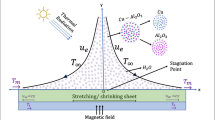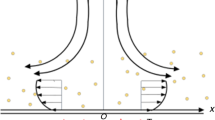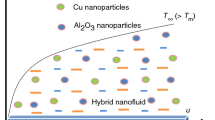Abstract
In this paper, the material forming process (such as that of the functionally graded materials) of adding nanoparticles into non-Newtonian fluids is considered. By adding nanoparticles to a non-Newtonian fluid, a new non-Newtonian fluid is created. Thus, the rheological characteristics of the original fluid matrix have been changed. This research attempts to consider the influence of the rheological characteristics combined with the Brownian diffusion, and the thermophoresis diffusion, the distribution of nano-sized particles, the heat transfer, and the pressure drop on the process of material formation. The configuration of material treatment process is an H-height horizontal parallel plate channel with laminar forced convection nanofluids-based non-Newtonian fluids flowing through. The channel is separated by three different boundary conditions: heating, cooling, and isolated, to simulate the melting, the freezing, and the flowing processes of materials in liquid form. The non-Newtonian behaviour of nanofluids is described by the power-law model. To highlight the rheological factors of power-law nanofluids which are not the same as those of the base non-Newtonian fluids, they are assumed to vary with the quantity of the added nanoparticles in the fluid matrix, that is to say, both the consistency coefficient \(m\) and the power-law index \(n\) are considered as functions of particle loading parameter \(\phi\). Two sets of different functions of consistency coefficient \(m\) and power-law index \(n\) are used and compared in the later calculation. Method of finite element is adopted to solve the coupled momentum, energy and concentration equations, and conquer the difficulties arsing in the iteration of calculation. It is found that whether the rheological factors of non-Newtonian nanofluids are considered changeable or not would lead to very different results of the mass transfer. Also, as the parameter \(N_{\text{T}}\) (depicting the thermophoresis diffusion) increases, both temperature and concentration profiles rise, while volume fraction of particles and temperature both fall as \(N_{\text{B}}\) number (presenting the Brownian diffusion) increases. Furthermore, when two models are compared, different rheological models may possess different change rule of power-law index, but in both rheological models, the diversification of power-law index is so large that it cannot be ignored in calculation. Above all, the detailed information of velocity, temperature, and pressure drop obtained by rheological models highlights the necessity of studying the impact of rheological characteristics of non-Newtonian fluids in elaborate industrial requirements.
















Similar content being viewed by others
Abbreviations
- \(c\) :
-
Specific heat (\({\text{J/kg}} \cdot {\text{K}}\))
- \(D_{\text{B}}\) :
-
Brownian diffusion coefficient
- \(D_{\text{T}}\) :
-
Thermophoresis diffusion coefficient
- \({\text{d}}t\) :
-
Time-step size
- \(H\) :
-
Channel height (m)
- \(k\) :
-
Thermal conductivity (\({\text{W/m}}\,{\text{K}}\))
- \(L_{i}\) :
-
Length of the channel wall (m)
- \(m\) :
-
Consistency coefficient (\({\text{Pa}} \cdot {\text{s}}^{n}\))
- \(n\) :
-
Power-law index
- \(N_{\text{B}}\) :
-
Brownian motion parameter (\(N_{\text{B}} = {{\rho_{p} c_{p} D_{\text{B}} } \mathord{\left/ {\vphantom {{\rho_{p} c_{p} D_{\text{B}} } {\rho_{f} c_{f} U_{0} H}}} \right. \kern-0pt} {\rho_{f} c_{f} U_{0} H}}\))
- \(N_{\text{T}}\) :
-
Thermophoresis parameter (\(N_{\text{T}} = {{\rho_{p} c_{p} D_{T} } \mathord{\left/ {\vphantom {{\rho_{p} c_{p} D_{T} } {\rho_{f} c_{f} U_{0} H}}} \right. \kern-0pt} {\rho_{f} c_{f} U_{0} H}}\))
- Pr:
-
Generalized Prandtl number (\({ \Pr } = {{c_{f} m_{f} H^{1 - n} } \mathord{\left/ {\vphantom {{c_{f} m_{f} H^{1 - n} } {k_{f} U_{0}^{1 - n} }}} \right. \kern-0pt} {k_{f} U_{0}^{1 - n} }}\))
- \(p\) :
-
Pressure (Pa)
- \(q_{i}\) :
-
Heat flux (\({\text{W/m}}^{2}\))
- Re:
-
Generalized Reynolds number (\({\text{Re}} = {{\rho_{f} H^{n} U_{0}^{2 - n} } \mathord{\left/ {\vphantom {{\rho_{f} H^{n} U_{0}^{2 - n} } {m_{f} }}} \right. \kern-0pt} {m_{f} }}\))
- Sc:
-
Generalized Schmidt number (\({\text{Sc}} = {{m_{f} \left( {{H \mathord{\left/ {\vphantom {H U}} \right. \kern-0pt} U}} \right)^{1 - n} } \mathord{\left/ {\vphantom {{m_{f} \left( {{H \mathord{\left/ {\vphantom {H U}} \right. \kern-0pt} U}} \right)^{1 - n} } {\left( {\rho_{f} D_{\text{B}} } \right)}}} \right. \kern-0pt} {\left( {\rho_{f} D_{\text{B}} } \right)}}\))
- \(T\) :
-
Temperature (K)
- \(U_{0}\) :
-
Inlet velocity (m/s)
- \(u,v\) :
-
Velocity components along \(x\) and \(y\) directions, respectively (m/s)
- \(v_{i} ,i = 0,1,2,3,4\) :
-
Weight function
- \(W\) :
-
Space of temperature and concentration
- \(x,y\) :
-
Cartesian coordinates along the channel plate and normal to it, respectively (m)
- \({\rm Z}\) :
-
Space of velocity
- Ω:
-
Domain
- Γ:
-
Boundary of domain
- ϕ :
-
Nanoparticle concentration (%)
- \(\rho\) :
-
Density (\({\text{kg/m}}^{3}\))
- \(\tau_{ij}\) :
-
Stress tensor
- 0:
-
Inlet conditions
- f :
-
Fluid
- p :
-
Particle
- eff:
-
Effective
- \(i\) :
-
Data at \(i \cdot {\text{d}}t\)
References
Akgöz B, Civalek O (2014) Shear deformation beam models for functionally graded microbeams with new shear correction factors. Compos Struct 112:214–225
Bég OA, Rashidi MM, Akbari M, Hosseini A (2014) Comparative numerical study of single-phase and two-phase models for bio-nanofluid transport phenomena. J Mech Med Biol 14:1450011
Bingham EC (1916) An investigation of the laws of plastic flow. US Bur Stand Bull 13:309–353
Bird RB, Armstrong RC, Hassager O (1977) Dynamics of polymeric liquids. Wiley, Hoboken
Chang PY, Chou FC, Tung CW (1998) Heat transfer mechanism for Newtonian and non-Newtonian fluids in 2: 1 rectangular ducts. Int J Heat Mass Transf 41:3841–3853
Choi SUS, Eastman JA (1995) Enhancing thermal conductivity of fluids with nanoparticles. No. ANL/MSD/CP-84938; CONF-951135-29, Argonne National Laboratory, IL (United States), pp 99–105
de Waele A (1923) Viscometry and plastometry. Oil Color Chem Assoc J 6:33–88
Ellahi R (2013) The effects of MHD and temperature dependent viscosity on the flow of non-Newtonian nanofluid in a pipe: analytical solutions. Appl Math Model 37:1451–1467
Eshgarf H, Afrand M (2016) An experimental study on rheological behavior of non-Newtonian hybrid nano-coolant for application in cooling and heating systems. Exp Thermal Fluid Sci 76:221–227
Fa F (2015) Natural frequencies and critical temperatures of functionally graded sandwich plates subjected to uniform and non-uniform temperature distributions. Compos Struct 121:197–210
Garoosi F, Jahanshaloo L, Rashidi MM, Badakhsh A, Ali ME (2015a) Numerical simulation of natural convection of the nanofluid in heat exchangers using a Buongiorno model. Appl Math Comput 254:183–203
Garoosi F, Bagheri G, Rashidi MM (2015b) Two phase simulation of natural convection and mixed convection of the nanofluid in a square cavity. Powder Technol 275:239–256
Garoosi F, Rohani B, Rashidi MM (2015c) Two-phase mixture modeling of mixed convection of nanofluids in a square cavity with internal and external heating. Powder Technol 275:304–321
Hamilton R, Crosser O (1962) Thermal conductivity of heterogeneous two component systems. I EC Fundam 3:187–191
Hojjat M, Etemad SG, Bagheri R, Thibault J (2011) Rheological characteristics of non-Newtonian nanofluids: experimental investigation. Int Commun Heat Mass Transf 38:144–148
Islami SB, Dastvareh B, Gharraei R (2014) An investigation on the hydrodynamic and heat transfer of nanofluid flow, with non-Newtonian base fluid, in micromixers. Int J Heat Mass Transf 78:917–929
Kang J, Zhou F, Tan W, Xia T (2014) Thermal instability of a nonhomogeneous power-law nanofluid in a porous layer with horizontal throughflow. J Nonnewton Fluid Mech 213:50–56
Li B, Zheng L, Lin P, Wang Z, Liao M (2016) A mixed analytical/numerical method for velocity and heat transfer of power-law fluids with high Reynolds number. Numer Math Theory Methods Appl 9(3):315–336
Li B, Lin Y, Zhu L, Zhang W (2016) Effects of non-Newtonian behaviour on the thermal performance of nanofluids in a horizontal channel with discrete regions of heating and cooling. Appl Therm Eng 94:404–412
Liu Z-H, Li Y-Y (2012) A new frontier of nanofluid research—application of nanofluids in heat pipes. Int J Heat Mass Transf 55:6786–6797
Marcotte M, Hoshahili ART, Ramaswamy HS (2001) Rheological properties of selected hydrocolloids as a function of concentration and temperature. Food Res Int 34:695–783
Moraga NO, Lemus-Mondaca RA (2011) Numerical conjugate air mixed convection/non-Newtonian liquid solidification for various cavity configurations and rheological models. Int J Heat Mass Transf 54:5116–5125
Moraga N, Medina E (2000) Conjugate forced convection and heat conduction with freezing of water in a plate shaped food. Int J Heat Mass Transf 43:53–67
Moraga NO, Ramirez SC, Godoy M, Ticchione PA (2010) Study of convective non-Newtonian alloy solidification in molds by the PSIMPLER/finite-volume method. Numer Heat Transf Part A: Appl. 57:936–953
Nie GJ, Zhong Z, Chen SP (2013) Analytical solution for a functionally graded beam with arbitrary graded material properties. Compos Part B Eng 44:274–282
Nield DA, Bejan A (2006) Convection in porous media. Springer, New York
Ostwald W (1925) Uber Die Geschwindigkeitsfunktion Der Viskosität Disperser Systeme. Kolloid Zeistricht 36:99–117
Putra N, Roetzel W, Das SK (2003) Natural convection of nano-fluids. Heat Mass Transf 39:775–784
Radulescu AV, Radulescu I (2006) Rheological models for lithium and calcium greases. Mechanika 3:67–70
Rashidi MM, Momoniat E, Ferdows M, Basiriparsa A (2014) Lie group solution for free convective flow of a nanofluid past a chemically reacting horizontal plate in a porous media. Math Probl Eng 2014:1–21
Sahmani S, Ansari R, Gholami R, Darvizeh A (2013) Dynamic stability analysis of functionally graded higher-order shear deformable microshells based on the modified couple stress elasticity theory. Compos Part B Eng 51:44–53
Santra AK, Chakraborty N, Sen S (2009a) Prediction of heat transfer due to presence of copper-water nanofluid using resilient-propagation neural network. Int J Therm Sci 48:1311–1318
Santra AK, Sen S, Chakraborty N (2009b) Study of heat transfer due to laminar flow of copper–water nanofluid through two isothermally heated parallel plates. Int J Therm Sci 48:391–400
Selimefendigil F, Öztop HF (2015) Numerical investigation and reduced order model of mixed convection at a backward facing step with a rotating cylinder subjected to nanofluid. Comput Fluids 109:27–37
Sheremet MA, Pop I (2015) Mixed convection in a lid-driven square cavity filled by a nanofluid: Buongiorno’s mathematical model. Appl Math Comput 266:792–808
Sheremet MA, Pop I, Shenoy A (2015) Unsteady free convection in a porous open wavy cavity filled with a nanofluid using Buongiorno’s mathematical model. Int Commun Heat Mass Transf 67:66–72
Shi H, Lin P, Li B, Zheng L (2014) A finite element method for heat transfer of power-law flow in channels with a transverse magnetic field. Math Methods Appl Sci 37:1121–1129
Sureshkumar R, Mohideen ST, Nethaji N (2013) Heat transfer characteristics of nanofluids in heat pipes: a review. Renew Sustain Energy Rev 20:397–410
Wang Z-H, Wang X-H, Xu G-D, Cheng S, Zeng T (2016) Free vibration of two-directional functionally graded beams. Compos Struct 135:191–198
Wu GH, Wu BY, Ju SH, Wu CC (2003) Non-isothermal flow of a polymeric fluid past a submerged circular cylinder. Int J Heat Mass Transf 46:4733–4739
Zeeshan A (2012) An investigation of porosity and magnetohydrodynamic flow of non-Newtonian nanofluid in coaxial cylinders. Int J Phys Sci 7:1353–1361
Zhu H, Kim YD, De Kee D (2005) Non-Newtonian fluids with a yield stress. J Nonnewton Fluid Mech 129:177–181
Acknowledgements
This research is supported by National Natural Science Foundation of China (11402188), China Postdoctoral Science Foundation (2015M580943), Beijing Postdoctoral Research Foundation (2016ZZ-13), and Natural Science Foundation of Shaanxi Province of China (Program No. 2015JQ1018). We are very grateful to Mr Fengbin Sun for all his support and help.
Author information
Authors and Affiliations
Corresponding authors
Appendix
Appendix
Define the domain as \(\varOmega \subset R^{2}\). Denote the boundary of \(\varOmega\) by \(\varGamma\), which is sufficiently smooth. Consider \(u\) and \(v\) in space \({\rm Z}\), which is defined as \(H^{1} (\varOmega )\) if \(n \le 1\) or \(W^{1,\,n + 1} (\varOmega )\) if \(n > 1\); \(T\) and \(\phi\) in \(W\), which is defined as \(W^{1,4} (\varOmega )\) if \(n \le 3\) or \(W^{1,\,n + 1} (\varOmega )\) if \(n > 3\), and \(p\) in \(L^{2} (\varOmega )\) (see Shi et al. 2014). The weak formulation of the conservation equations is as follows:
In the above weak formulation, a unique item \(- \int\nolimits_{\varGamma } {\left( {2\left( {\frac{\partial u}{\partial x}} \right)^{2} + 2\left( {\frac{\partial v}{\partial y}} \right)^{2} + \left( {\frac{\partial u}{\partial y} + \frac{\partial v}{\partial x}} \right)^{2} } \right)^{{\frac{n - 1}{2}}} \frac{\partial u}{\partial y}v_{2} {\text{d}}s}\) has shown itself in weak formulation of the momentum conservation equations. It will only appear in the case of non-Newtonian fluids, which exhibit nonlinear viscous items.
To deal with the super-nonlinear terms \(\tau_{ij}\) in equations (21–22), a specific iterative method is employed by introducing a ‘ghost’ time into the momentum equation:
where
\({\text{d}}t > 0\) represents the time-step size. The superscript \(i\) means data at \(i \cdot {\text{d}}t\). The equation will hold even when the velocity is unchangeable once steady-state reaches. In the present research, the momentum equation is iterated 200 times to reach a steady-state.
Furthermore, the consistency coefficient \(m\) and the power-law index \(n\) are assumed varying as the particle loading parameter \(\phi\), that is to say, following iterations should be included in the calculation:
Rights and permissions
About this article
Cite this article
Li, B., Zhang, W., Bai, B. et al. On rheological characteristics of non-Newtonian nanofluids in the material forming process. Microfluid Nanofluid 20, 154 (2016). https://doi.org/10.1007/s10404-016-1818-y
Received:
Accepted:
Published:
DOI: https://doi.org/10.1007/s10404-016-1818-y




